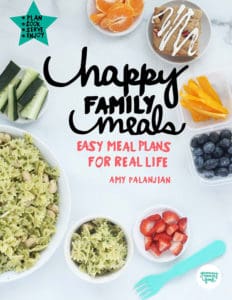Welcome to YTF Community, a place to safely share in the challenges and joys of feeding our families. If you’re looking for recipes, feel free to go right to the home page of yummytoddlerfood.com.
I have a serious holiday hangover (well, mostly it’s from the stomach flu that also hit out house…sigh!), but our appetites are coming back and I have the ingredients on deck to make a batch of my No-Cook Brownie Bites for snacks. But the real reason that I’m writing today is that I wanted to talk through something that has become increasingly important to me as a mom:
Letting go of the pressure to constantly “get the kids to eat”.

I wanted to write about this today because it came up during my appearance on the Tamron Hall Show that aired last week (which was so surreal to get to do!) and a relative who watched it told me that they loved hearing my “mission statement” at the start.
To be honest, I had never thought about this that way, but I think it’s true. Here’s what I said in response to her question about how I know how to make the recipes that I share:
“I think it’s really knowing that the goal isn’t to get the kids to eat specific foods. It’s to create an environment where they feel comfortable and safe enough to try things, and to be together. So it’s taking some of that pressure off.”
Which didn’t even answer her question because my response didn’t speak to specifics about food or my recipes at all. But we so often miss this context when it comes to how we think about feeding our kids. And I think that’s what I’ve learned in the more than decade of running my brand, in hearing from others, and from being a mom myself: It’s not just about the food.
Often, it’s not even about the food at all.
This idea that we forever need to “get” the kids to eat sets us up to be chasing them in a way that can make the situation so much more fraught for everyone. Even that language makes it sound exhausting. And it’s Really, Really, So Very Difficult to get any other human to do any specific thing we want them to do. We’re setting ourselves up to fail before we even start.
Yes, I am aware that it IS exhausting to care for a family, especially when it includes toddlers who are still figuring out how to communicate with us. But I also know that it can feel less like an all-encompassing burden if we can remove some of the pressure to get our kids to eat a list of foods and dishes in certain amounts, at certain times of the day.
If we can stop trying to “get” them to eat, and focus on the bigger picture of the context in which we’re eating and feeding them.
Here’s what this means for me in the reality of my own home:
- The kids can choose what’s for breakfast from the options that I have on hand. I am available for (about) 30 minutes in our morning routine to help them, so I may make bagel sandwiches or help pour milk as needed. I do my best to encourage them to help themselves as they can according to their own age. (I often make muffins and chop fruit so it’s ready for them to grab.) And I don’t cook two different things on the same morning if I can help it.
- I decide what’s for dinner on the nights that I cook, taking the kids preferences into account and keeping my own desires front of mind.
- I aim to include 1-2 foods in each dinner that the kids like to ensure they always have something to eat—even if that’s not the main dish. This means there is always fruit on my table.
- Dinners show up to the table family-style, and deconstructed more often than not. So the taco options are in separate bowls or on a big platter. The chicken is on the side of the Caesar Salad. The Rice Noodle Soup has toppings on the side. I cut veggies big enough to scoot out of the way if I’m making a stir fry. This ensures that we can all put the foods we like onto our plates from the ones I’ve offered. (It also means I don’t often make casseroles since those are harder to do this way!)
- If a child decides not to eat or not to each much at dinner, my first assumption is that they aren’t as hungry as I expected. I do not consider this a problem for me to solve due to the list of things above, but I do remember that fluctuations in appetite and preferences are totally normal.
- If a child decides not to eat but says they are hungry, I try to offer them a way to engage with their food in a novel way. I may hand them tongs, my son may get up and grab his kid-size food scissors to cut up his food, or I may grab a dip or condiment I forgot or they request. I also remind them of the options that we have on the table.
- We have dessert every night (currently it’s still Halloween candy) and the option of a bedtime snack every night, which right now is sliced apples.
I’ve been leaning into this system for years, so my kids expect it and almost never ask for something else that’s not on the table. (I can think of one time in recent months when my oldest really disliked what I’d set out and asked if she could make herself a peanut butter and honey sandwich.) When they don’t love a meal, I choose not to see that as a failure. I have a lot of empathy for kids who don’t have a ton of control over their food options! (I would be a disaster of a human if someone else decided what to feed me all day long!)
This balance of parental control and then child flexibility within it has alleviated many power struggles for us at the table. It also ensures that while I do a lot of work to feed my family, I am not engaged in the mental gymnastics that can ensue when you are forever chasing the food whims of a child on any given day. It is absolutely not perfect and there are nights when no one is thrilled with what I’ve decided to make, but they also know that it’s normal to not see their favorites at every meal.
Agree? Disagree? Questions? Comment below!






















All comments are subject to our Terms of Use.